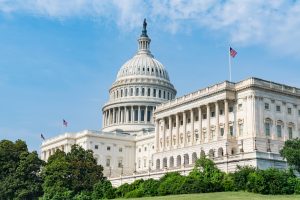 Recently, Market Connections released their 2020 Federal Media and Marketing Study results, providing a look at how the pandemic has shaped the way the federal buyer consumes media. Findings from 2020 can support marketers in short term planning and serve as a basis for longer term thinking about what their marketing strategy should look like.
Recently, Market Connections released their 2020 Federal Media and Marketing Study results, providing a look at how the pandemic has shaped the way the federal buyer consumes media. Findings from 2020 can support marketers in short term planning and serve as a basis for longer term thinking about what their marketing strategy should look like.
The biggest long-term change is the location of where people work. Prior to March 2020, only 5% of federal workers were teleworking full time. This number moved as high as 59%, and while it will drop in the future, 27% report they expect to telework full time in the future. Another 46% expect that partial telework will be a regular routine moving forward.
This working arrangement means there is less consumption of media during commutes. It also shows that federal employees are now spending more time with online media and social sites as they have more access to personal devices and are free of workplace access restrictions. This opens up more opportunities to reach this audience. Radio ads can now be spread out throughout the day and general news sites can become a bigger part of the media mix with greater access.
Of course, working from home has also greatly impacted the events market. With events moving to virtual platforms, they have also become part of the media mix. An event can be held live and then archived for on-demand viewing. This allows for more metrics to be captured on views and actions from events, allowing for closer comparison between them and other marketing channels than ever before.
As reported earlier this year, government attendees do not see themselves attending large, in person events before April 2021. Smaller events (100 people or less) will be the first to come back live, but that does not mean virtual events will go away. People have grown comfortable with the online event format. The number of people attending 4 or more virtual events jumped from 34% to 56% in 2020. The study found that people still like to attend these online events live, but almost all respondents (94%), report watching recorded sessions either during the workday or after hours.
When it comes to on-demand sessions, people prefer 30-60-minute sessions. Event organizers have found that live events benefit from shorter sessions-- 30 minutes or less--that focus on solutions, not spending time laying out challenges that people are already familiar with. Sessions that offer demonstrations or practical solutions tend to be well-received.
On-demand events also provide a host of new content for marketers. The recordings can be promoted numerous times throughout the year. The content presented can be segmented into shorter videos or translated into other content marketing pieces such as blogs and e-books.
When in-person events become an option, event planners will need to make the case for why people should come. For example, a teleworker who only works two days in the office, will they be willing to spend some of that time at an event as opposed to meeting with co-workers? If they are working from home, why should they add a commute to their day for an in-person event? It will be critical to answer these questions as part of the event planning and promotion process. Interestingly, the study found that people outside of the DC metro area are more open to in-person events sooner. The migration to in-person events may start in areas outside of DC as a test run to building up to more and larger events in the future.
You can get access to the full study and presentation here. Let us know what your key takeaways were and how you are approaching 2021 planning in the comments.
Have an upcoming virtual event? Be sure to add it to GovEvents to reach our 100,000+ members and beyond.




